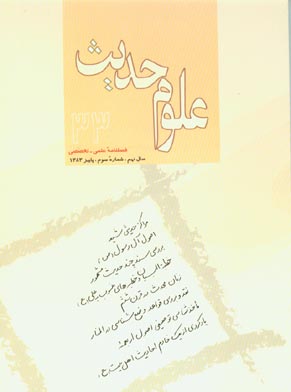فهرست مطالب

فصلنامه علوم حدیث
سال نهم شماره 3 (پیاپی 33، پاییز 1383)
- 222 صفحه،
- تاریخ انتشار: 1383/09/15
- تعداد عناوین: 14
-
-
صفحه 3
-
صفحه 29
-
صفحه 83
-
صفحه 165
-
صفحه 193
-
صفحه 207
-
صفحه 218
-
Page 3The editorial deals with the importance of history of hadith and approaches to hadith transmitters from a geographical perspective.Introducing some of the Shiite and Sunni works on hadith, editorial mentions the necessity of viewing them from geographical point of view and investigating them by their location.The author also points to the way a hadith scholarship center is established and renders some methods for investigating hadith scholarship centers.
-
Page 9Sometimes it is assumed that there is no relation between the science of Usul Fiqh and Hadith but evidences shows another thing.Some scholars have written books in which hadiths utilized by Usul Fiqh are introduced. The book Usul of Al – I Rasul is one of them.Utilizing the writings on the margins of Furu,al – Kafi, the author of this article tries to represent some parts of the above-mentioned book.
-
Page 29The author, in this article, tries to defense his opinions concerning the reliability of some Mashhur Hadiths and respond to a critical review of his previous article.In previous issue, he viewed these Mashhur hadiths from two perspectives namely text and content.Finally the author concludes that there is no trace for these Mashhur Hadiths in our hadith literature although there are similarities between some hadiths by content or meaning.
-
Page 49With reference to books which has been written after sixth century and are now available. It is find out that some ascribed sermons to Imam Ali, peace be upon him are not traceable in Nahjul Balagha.Sometime the content of this sermons exist in Nahjul Balagha but we can find some differences in wordings.The author concludes that most of these sermons are made up and are not compatible with Imam Ali,s Status.
-
Page 83In the present article, ninety two women transmitters who related hadiths are extracted from two hadith books and introduced, followed by a chart of their geographical location. Hence, it becomes evident that women played an important role in transmitting hadith since they transmitted a considerable number of hadiths, such hadiths are noteworthy with regard to their content and the social influence they exerted. The author renders a geographical approach to hadith and importance of geographical location concerning the relation of hadith.
-
Page 106A Study about Sulaym Qays Hilali is the title of an article written by Dr. Abdul Mahdi Jalali which was published in the Islamic Studies Quarterly.The reviewer of the abovementioned article believes that there is no evidence in historical resources, and viewing from different perspectives, the reviewer tries to prove his view.
-
Page 123In the previous part, the writer rendered brief introduction to the life of Ibn Qayyim and his works, followed by some critical comments on his book al – Minar.In the present part, the discussion on studying the modes of making up of hadiths as formulated by Ibn Qayyim, and the necessity of reconsideration of hadiths are brought to light, followed by his classification of hadiths.
-
Page 144Al – Kafi, Tahdhib al – Ahkam, al – Istibsar, Man La Yahdaruhu al – faqih are four authentic books of Shiite.The present article tries to provide a bibliography of the above mentioned books followed by a list of different prints and translations as well as commentary and notes.
-
Page 165Many hadith scholars have written about the Usul Arba,umi,a. the author of the present article has collected these writings. While introducing them, the author mentions the characteristics of each writing as well as their similarities and differences
-
Page 179This review is concerned with the book Royaye Kholus, a book written by Sayyed Hasan Islami on the separation school of thought (a newly – established theological school of thought).The author of the book rejects this school of thought because of some deficiency which exists within it.The reviewer, in agreement with the author, tries to introduce different parts of the book and finally renders some suggestions for the improvement of the materials of the book.
-
Page 193Ali Naqi Faydulislam is one of those translators of Nahjul Balagha whose translations were, to the present moment, well received by the public.A conference was held in June in Isfahan commemorationg this great scholar, under the title of Translation of Holy Texts.The present paper is a report of this conference including the papers presented in and works published on conference

